Action for Primates
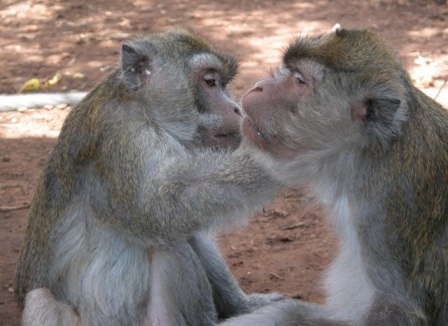
|
Action for Primates |

|
|
The following are news items we have posted in 2020. See elsewhere for news from other years.
Index of news items; select date & title to access:
23 December 2020: Monkeys used to study teenage alcohol use disorder
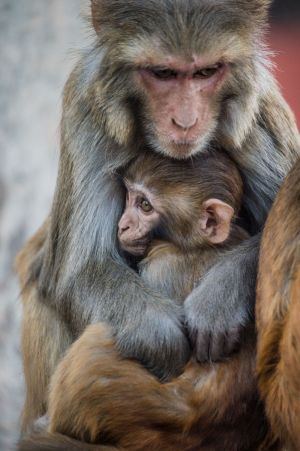
The work, purportedly to identify ...predictors of [human] teenage alcohol use disorder...
, was done at the National Institute of Child Health and Human Development in Maryland, USA, and supported primarily by public funds. The research involved 145 laboratory-born rhesus macaques (64 females, 81 males), ...housed at the Laboratory of Comparative Ethology, National Institute of Child Health and Human Development colony as part of an ongoing, longitudinal study investigating genetic and environmental influences on neurobiology and behavior as they relate to alcohol consumption.
(1)
Some of the infants (63) were allowed to remain with their mothers until 6-7 months of age, while others (82) were separated from their mothers at just 1-3 days following birth and reared in a neonatal nursery
where they were given a fleece-covered object as a surrogate mother
and a cloth blanket. Their behaviours were observed and recorded.
When the monkeys were about 3-4 years old, they were ...tested for their propensity to voluntarily consume alcohol.
They were initially trained
to drink an artificially sweetened solution from nipple-like spouts. Ethanol (alcohol) was subsequently added to the solution until an 8.4% v/v alcohol solution was produced. The ethanol solution was then made available to the monkeys for one hour each day, four days a week (Monday through Thursday), for between five and seven consecutive weeks. The monkeys were able to self-administer alcohol while housed alone or socially with other monkeys.
The assessment of alcohol intake occurred over a period of seven years and under different conditions. There were differences in alcohol consumption based on neonatal temperament
. The nursery reared
monkeys were more likely to consume alcohol at rates that produced intoxication when compared with mother reared monkeys. There was also a binge-like rapid intake, with about two-thirds of the available alcohol consumed in the first 15 minutes.
Aside from the immorality of using non-human primates in such despicable research – removing infant monkeys from their mothers and turning them into 'binge drinkers' – the complex combination of factors involved in human behaviour – including genetics, emotional and personal experiences, socioeconomic factors – can never be simulated in others. This research, paid for by the US taxpayer, has continued for decades and will likely continue far into the future. In the meantime, people with the disease of alcoholism will continue to suffer waiting for a 'cure' from scientists, rather than society addressing the fundamental issues that can never be resolved through non-human primate research.
References:
21 December 2020: Mauritius monkeys used in sperm preservation research in USA

Monkeys from Mauritius have been used in research in the USA in which male long-tailed macaques were subjected to penile electrical stimulation
while under sedation to collect sperm (1). Female long-tailed macaques were injected multiple times (twice-daily, by intramuscular injection, for 11 to 12 days) with recombinant human follicle stimulating hormone and once with human chorionic gonadotropin in order to cause ovarian hyperstimulation. Ovarian hyperstimulation syndrome is an exaggerated response to excess hormones and can cause the ovaries to swell and become painful. Eggs (oocytes) were retrieved by laparoscopic aspiration [incision into the abdomen and use of steel needle to withdraw eggs] between 38 to 40 h after the [human chorionic gonadotropin] injection.
Fertilisation was subsequently achieved in 12 out of 15 oocytes.
Some of the macaques were supplied by Bioculture Mauritius, the others from Covance Research Products. The work was done at the Wisconsin National Primate Research Center (WNPRC) and was paid for entirely with public funds (NIH).
A recent investigation carried out by PeTA at WNPRC revealed that almost 2,000 monkeys are kept in barren metal cages. PeTA's findings make disturbing reading, including stressed monkeys displaying disturbed behaviour and causing injuries to themselves. The revelations also included male macaques being strapped into a restraint device before staff used electroshock on their penises until the animals ejaculated. Because the authors of the paper we report here stated that sperm from the monkeys were collected through penile electrical stimulation
, we have to assume the method discovered by PeTA was used on the monkeys from Mauritius.
The stated goal of the research on the Mauritian macaques was to develop a protocol for freezing the sperm to provide an effective way to preserve it, to facilitate in vitro fertilisation (IVF) experiments and to allow the application of genome editing strategies in these Mauritius monkey embryos. None of this, of course, is intended to help Mauritian macaques, not could it ever be the case. Instead, the information will ...be used to create a [Mauritian cynomolgus macaques] sperm cryobank and as a model for genetic engineering
. Once again, monkeys are being treated as living 'test tubes', with no concern for their well-being or providing them with the dignity and moral constraints that are routinely afforded people.
Reference:
18 November 2020: Hearing loss and damage deliberately induced in monkeys by loud noise
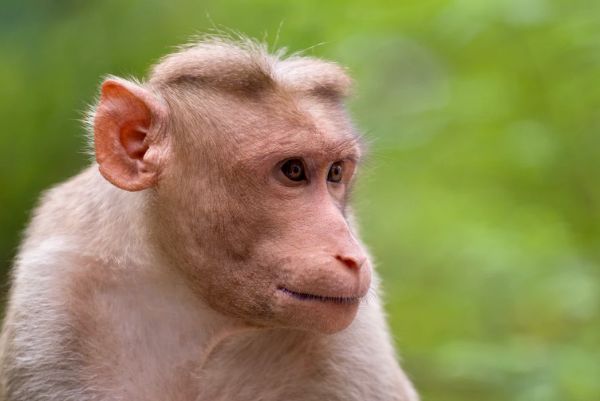
This abysmal work was carried out at Vanderbilt University, Tennessee, supported by public funds and approved by the Animal Care and Use Committee at the Vanderbilt University Medical Center (1). The monkeys were used as an 'animal model' for noise-induced hearing loss. They were deliberately subjected to extremely loud noise of 141 or 146 dB with the intent to cause hearing impairment and cochlear damage
to then assess their 'performance' on various audio-based 'tasks'.

One male rhesus and two male bonnet macaques were used in the research and five male rhesus macaques were used as 'controls'. Prior to exposing them to loud noise, each monkey had a 'head holder' surgically implanted into his skull. This device was used later during 'testing' so that the head was severely immobilised while the monkey was generally restrained in what is called an Audio Chair™ System, manufactured by Crist Instrument Co. The monkeys had been 'trained' to perform certain tasks, using fluid reward
. Although not described, using fluid rewards almost always requires restricting water intake in order to 'motivate' the monkeys.
The exposure to the loud noise was done over a four-hour period, while the monkeys were sedated in a sound-proof chamber, with earphones deeply inserted
into each ear canal. The noise was 141 dB (decibel - the unit used to measure the intensity of a sound) for one monkey and 146 dB for the other two individuals. The intent was to cause hearing impairment and cochlear damage
.
The macaques, presumably including the individuals used as 'controls' for comparison, were killed after the experiments to study tissue related to hearing.
No information was provided on the clinical signs or description of the behaviour of the monkeys following the exposure to the noise and damage to their hearing. According to the Centers for Disease Control and Prevention, noise above 120 dB can cause immediate harm to a person's ears. The sound an engine produces when a jet plane is taking off creates 120 dB of noise and 140 dB is the noise to which you would be subjected by certain gunshots or firecrackers. Any exposure by humans to noise above 140 dB causes immediate hearing damage and pain. Noise above 140 dB is considered to be in the deadly range
for people, leading to physical distress, shortness of breath, nausea, nosebleeds and other severe discomfort. Even below that level, noise can still cause permanent problems including hearing loss and persistent tinnitus. The monkeys in this experiment were allowed to live and suffer the effects of the loud noise damage to their ears – possibly with rupture of their eardrums – for many weeks.
The considerable and deliberate suffering inflicted upon these monkeys is highly distressing. These individuals were being used as surrogates for noise-induced hearing loss in people. We know, however, that sophisticated and morally defensible methods could be used to study people who have hearing abnormalities – such people have been studied for decades
according to the researchers themselves. These studies would not only be humane, they would produce data that are directly relevant to people.
Reference:
14 November 2020: Update: Airline cuts ties with cruel primate trade

In May 2020, Action for Primates joined with Animal Rights Florida Foundation and One Voice to alert our supporters about a pending shipment of monkeys from Mauritius to the US. As many as 1,200 monkeys were to be exported for use in experiments or toxicity (poisoning) testing. We urged people to ask Skybus Jet Cargo, who had been hired to fly the monkeys on the extremely long journey, to reject the shipment. The response we received to our action alert from people around the world was overwhelming, demonstrating the widespread public concern there is on this issue. However, despite this, Skybus did not respond to our concerns, so we feared that the shipment had gone ahead as planned.
This week, we learned of a breach of contract lawsuit filed against Skybus Jet Cargo by a company called International Logistics Support. When we read the complaint, it was clear that the lawsuit was about the shipment of monkeys in our action alert. Skybus Jet Cargo apparently had cancelled the shipment, in part because of certain political activist organizations
. On behalf of the monkeys, we are happy that Skybus chose not to get involved in the cruel primate trade.
The surprise victory reminds us of a quote attributed to Mahatma Gandhi: You may never know what results come of your actions, but if you do nothing, there will be no results.
We are grateful to everyone who contacted Skybus Jet Cargo in response to our action alert!
The court files also revealed that Matthew Block, an infamous US primate dealer, is an owner of International Logistics Support. Matthew Block, founder of Worldwide Primates, has a felony conviction from 1993 for smuggling orangutans, known as the 'The Bangkok Six' case, that left three orangutans dead. Further, in 2018, it was reported that Block pleaded guilty to a federal charge of intentionally conveying false information through the mail, in an attempt to frame animal campaigners in Florida. Block accepted five years of probation and agreed to pay $14,872 for the cost of the police investigation.
4 October 2020: Over $2 million federal grant given for monkeys to be used in alcohol research

Oregon National Primate Research Center (ONPRC) in the USA has announced that it has received a new $2.4 million federal grant for research into alcoholism, including analysing the effects of heavy alcohol drinking concurrently with COVID-19 infections. This announcement shows a 'cheerful' photo of monkeys at the ONPRC. The reality of life – and death – for the monkeys, however, is dramatically different from this public relations photo. A recently published study provides a disturbing insight into the kind of ethanol (alcohol) research to which monkeys similar to those in the photo are being subjected at the ONPRC and paid for entirely with public funds (National Institutes of Health) (1). It was approved by the institutional animal use committee of the ONPRC.
The ONPRC has been carrying out alcohol research on non-human primates for many years, including 'inducing' pregnant macaques to binge drink to look at the impact of alcohol on their foetuses. It appears now that monkeys will not only be forced to become heavy alcohol drinkers, but will also be infected with the coronavirus that causes COVID-19.
Alcohol abuse is a serious illness suffered by millions of people, yet keeping monkeys in cages and forcing them to become 'alcoholics' in an attempt to help people is not only immensely cruel, it fails to address the human situation which is far more complex than simply the consumption of alcohol-containing drinks. Furthermore, research on mifepristone, the drug that was used in the monkey study, is already being studied in people as a treatment for alcoholism.
Twelve adult male rhesus macaques were used (nine described as ethanol drinkers
and three as controls
who had never had ethanol). The ethanol drinkers
were coerced into drinking alcohol using food rewards and by slowly increasing the amount of alcohol in their only source of water. Eventually, the macaques were drinking up to 1.5 gm of 4% ethanol per kg body weight every day. Only after they had drunk the required amount of ethanol was plain water made available.
By six months, the average daily ethanol intake ranged from 1.64 to 4.02 gm/kg/day and the researchers described the monkeys as two light drinkers, one binge drinker, four heavy drinkers and two very heavy drinkers
. Such a description appears to downplay the seriousness of what the monkeys were experiencing.
The macaques were then forced to undergo periods of forced abstinence
where they were cut off from the ethanol, before being allowed access again. Mifepristone, the test drug, was given several times in food during these drinking trials to assess the impact on the amount of ethanol consumed by the macaques.
There is no information provided on the behavioural effects of ethanol on the macaques nor whether they showed signs of 'withdrawal' when ethanol was withheld. Withholding alcohol in alcoholic people can result in sweating, rapid heartbeat, hand tremors, problems sleeping, nausea and vomiting, hallucinations, restlessness and agitation, anxiety, and occasionally seizures. It is almost certain that the macaques would have experienced some of these effects, but with the added trauma of having no understanding of why and being confined in a cage. Although not stated explicitly, the use of the term necropsy
several times in the report suggests that all the monkeys were killed at the end of the research.
The researchers reported that the test drug ...reliably decreases average daily ethanol self-administration in a non-human primate model
but did not prevent or reduce relapse drinking
. Foretelling more misery and death for other macaques, the researchers stated that ...additional research is needed to determine whether [mifepristone] can be an effective treatment...or would be safe for long-term administration
.
As acknowledged by the authors, research on mifepristone to treat alcoholism in people is already being done. In one such study, the drug was found to be effective and well tolerated
.
The test drug, mifepristone, is produced by Corcept Therapeutics and one of the authors has acknowledged being an employee at Corcept Therapeutics
. This raises the issue of a potential conflict of interest by someone who appears to have a vested interest in the outcome of the work.
Reference:
27 September 2020: A shameful legal global trade in wild-caught non-human primates
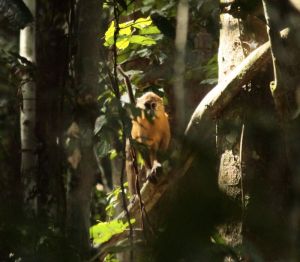
The legal global trade in wild-caught non-human primates is shameful, especially at a time when there is increasing awareness of the threats facing non-human primates and the destructive impact human activity is having on the environment.
Sixty-five percent of all non-human primate species live in just four countries, including the Democratic Republic of the Congo (DRC). A recent global assessment by the International Union for Conservation of Nature (IUCN) revealed serious threats faced by non-human primates in Africa. An estimated 53% of the species (54 of 103) are now under threat of extinction. According to Dr Grethel Aguilar, IUCN Acting Director General: This IUCN Red List update exposes the true scale of threats faced by primates across Africa. It also shows that Homo sapiens needs to drastically change its relationship to other primates, and to nature as a whole.
(The IUCN's Red List of Threatened Species is the world's most comprehensive information source on the global conservation status of animal and plant species.)
Data submitted to the Convention on the International Trade in Fauna and Flora (CITES) by the DRC reveal over 1,000 non-human primates were captured and exported from the DRC during 2019. Some of the species are classified as 'Endangered', with populations decreasing according to the IUCN. These include the golden-bellied mangabey (Cercocebus chrysogaster) and greater spot-nosed monkey (Cercopithecus nictitans). Threats already facing both species in the DRC include habitat loss and hunting. According to the IUCN, at least 32% of habitat has been lost and populations of the golden-bellied mangabey, native to the DRC's equatorial rainforests, are dramatically declining as a result of uncontrolled bushmeat hunting. Despite this, the golden-bellied mangabey is not on the list of protected species under the DRC national law and, in 2019, 60 of these individuals were captured from the wild and exported to Ghana, Mali and Thailand.
Other wild species exported from the DRC during 2019 included L'Hoest's monkey (Cercopithecus lhoesti) and the Angolan black-and-white colobus (Colobus angolensis), both classified as 'Vulnerable' with populations decreasing. According to the IUCN, threats to both species include habitat loss and being hunted and trapped for bushmeat.
The IUCN Red List categories of Endangered and Vulnerable means that the species are threatened with global extinction.
According to CITES, a national export quota of over 3,000 wild-caught monkeys, including L'Hoest's, putty-nosed, mona and De Brazza's monkeys, was allocated by the DRC for 2020.
A legal wild-caught trade can also mask or encourage an illegal one, and, combined with habitat loss, all these threaten the survival of a species and have a devastating impact on individual lives as family groups are forcibly separated and ripped from their native habitat.
We urge all countries to protect indigenous populations of non-human primates from habitat loss and hunting and to not grant permits that allow them to be captured and exported.
24 September 2020: Infant monkeys deprived of mothers and reared in dim light
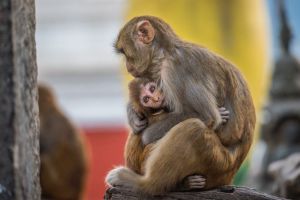
This recently published research involved rearing infant monkeys in low intensity lighting to find out whether it causes myopia (near-sightedness). The work was carried out at the University of Houston in the USA and involved researchers from the Brien Holden Vision Institute in Australia, a non-profit, non-governmental organisation. It was supported by public funds (the National Institutes of Health, the Brien Holden Vision Institute and the University of Houston Foundation). The research was approved by the University of Houston animal use and care committee.
Seven two-week-old infant rhesus macaques (Macaca mulatta) were used. The infants had been kept in what the researchers euphemistically called a primate nursery
prior to being acquired
for the experiment. Although not specifically stated, this strongly suggests the infants had been removed from their mothers soon after birth, certainly well before they reached two weeks of age. They continued to be subjected to maternal deprivation throughout the experiment. Forcibly separating infants from their mothers, and then depriving them of each other, is an extremely distressing experience for mother and infant, and one of the cruellest situations to which primates, including human ones, can be subjected.
At about 24 days of age, the infants were transferred to another nursery
in which there was reduced lighting (during typical 'daylight' hours, then the lights went off during typical 'night-time' hours). They remained under these conditions (except for brief removals to do measurements on ocular development) for the remainder of the experiment (until they were about 10 months or 310 days of age). The overhead lighting in the room during 'daylight' hours was only 55 lux, but the amount of light as measured at the fronts of the cages was only seven to 36 lux; this is completely aberrant for the normal habitat in which rhesus monkeys live. In addition to being kept under these dim conditions, infants were denied the nurturing and security of their mothers and the companionship of each other. The authors state: Our rearing environment was very dim in comparison to typical outdoor lighting levels. In this respect, our light levels were just above twilight light levels typically encountered outdoors...Moreover, our lighting levels were dim in comparison to indoor lighting standards.
The minimum lighting recommended for people in a work area is 100 lux, but as much as 500 lux if they work in an office. In a previous study, the authors stated that typical laboratory lighting levels averaged 580 human lux
. These infant monkeys, therefore, had to endure not only the distress of social and maternal deprivation and a completely abnormal environment for their well-being, but also the near-dark conditions. Control data were acquired from age-matched monkeys who were reared similarly, but under typical laboratory lighting.
For the periodic tests to measure ocular development, the infants were injected with a sedative (ketamine) and their heads were covered with a light-blocking cloth
while they were transferred to the measuring facility to collect data, including inserting contact lenses. These tests were carried out every two weeks for the first seven months, then every month until the end of the experiment. No information was provided as to the fate of the seven infant monkeys.
The authors found that dim-light rearing of these monkeys did not result in myopia, rather it subtly altered ocular structure and optical refraction (bending of light). No tests were done to determine if any of this had any effect on vision for these individuals; all the measurements were physical, not functional, in nature.
The data derived from this inhuman treatment of infant monkeys are essentially valueless. The authors even acknowledged this:
A limitation of our study was that the illumination level, as well as the duration of exposure, was not representative of real-world scenarios. In addition, whereas transitioning between relatively lower and higher ambient lighting frequently takes place in daily life; our subjects were deprived of such opportunities. Transitioning between ambient lighting conditions might be physiologically impactful because temporal contrast might serve as an additional trigger for retinal dopamine release. These limitations suggest that the observed refractive effects of dim lighting might be largely exaggerated.
Furthermore, research has already been done in people to show that an increase in ambient light protects children from developing myopia. Why, therefore, were these infant macaques deliberately caused to suffer when not only are the data not applicable to people (or even other species of monkeys: These results showed that, for rhesus monkeys and possibly other primates...
[emphasis added]), but it was already known that it is important to provide adequate light in human children in order to promote normal development in refractive ability? This is work simply designed to continue using non-human primates as 'models' for human refractive error development, as alluded to by the authors.
Vision research on infant macaques, involving some of the US and Australian authors of this study, has been carried out over many years, also publicly funded by grants from the National Institutes of Health, funds from the Vision Cooperative Research Centre in Australia (Brien Holden Vision Institute) and the University of Houston Foundation. One such study involved rearing infant monkeys with red filters over one or both of their eyes. The filters were held by goggle helmets that provided monocular and binocular fields of view. Except for brief periods needed for routine cleaning and maintenance, the monkeys wore the helmets continuously from about 25 to 146 days of age.
It is disturbing that researchers appear to have a casual approach to the removal of infant monkeys from their mothers. This type of research, which is of no medical value to human patients, but of enormous psychological cost to the monkeys, should be discontinued. The authors, however, advocate the carrying out of further similar research using non-human primates.
References:
Published under Creative Commons license
16 September 2020: Baboons used as both donor and recipient in disturbing womb transplantation research
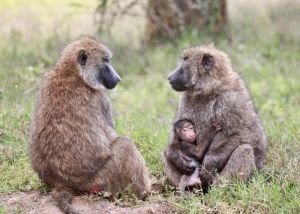
Baboons were used in uterine autotransplantation research, published late in 2019. The uterus, ovaries, fallopian tubes, cervix and part of the vagina were surgically removed from each animal and then replaced and sutured back into the same animal.
The work was carried out at the Institute of Primate Research (IPR), Nairobi, Kenya, and approved by its institutional ethical committee
. Most of the researchers were from facilities in California, Texas and Mexico The only financial support reported was self-funding by one of the authors from Community Memorial Hospital, Oxnard, CA, USA. The research was referred to as a pilot study
, which means further similar research on baboons is likely.
The purpose of this pilot study
was to develop surgical techniques in uterine autotransplantation in baboons. Eight adult female baboons were used, but there was no mention of the species or the source of the animals, although the IPR has previously carried out research on wild baboons captured in Kenya. After anaesthesia, an incision was made into the abdomen to remove the reproductive tract as one block of organs. The organ block was taken to a back table
where the blood vessels were irrigated with a saline and heparin solution until all blood was removed and the organ turned white
. This preparation procedure lasted for two to three hours, presumably while the baboon remained under anaesthesia on the surgical table. The reproductive tract was then placed back into the same animal
and reattached with sutures. This was complex surgery and, in all, the animals were subjected to an average of about six hours of surgery. Afterwards, they were taken to a postoperative recovery area.
Shockingly, three of the baboons died immediately post-surgery, two from severe dehydration
and one from postoperative gastric aspiration
(taking stomach contents into the lungs after vomiting). The researchers note that surgery time was longer because the donor and recipient were the same animal and this may have contributed to the increased mortality. The only likely way for an animal to die of dehydration, however, would be if adequate fluids were not provided or if the animal was not drinking. If an animal is not drinking, however, proper procedure would be to supply fluids in alternate ways, such as intravenously, subcutaneously or via gavage ('stomach tube'). For an animal to die of dehydration in a situation like this means there could not have been adequate monitoring.
Gastric aspiration as a cause of death also raises questions about whether proper procedures were followed. There was no mention whether food and fluids were withheld prior to surgery, as must be done in order to reduce the chance of regurgitation. When an animal is under anaesthesia, a properly applied endotracheal tube should prevent aspiration in the unlikely event that an animal vomits (regurgitates) while under anaesthesia even if food and fluids had been properly withheld. This is the reason why the endotracheal must not be removed until the animal is conscious enough to assume normal bodily functions such as swallowing. That way, if the animal vomits, he or she can swallow, reducing the chance of aspiration. Because the authors provide no details on how the baboon died of gastric aspiration
, there is no way to know if this happened despite proper monitoring.
Three other animals suffered from leg weakness, which the researchers attributed to hyperextension of the lower extremities (hind legs). The animals were kept in cages where they were monitored for a few days. They were followed up for only one month after surgery, before being donated back
to the primate centre. The researchers claimed that, because of the limited goals of the study (only evaluating surgical technique), there was no need for long-term follow up of the animals. Aside from following up from an animal welfare perspective, an important part of assessing the effectiveness of surgical technique is to determine if it allows for normal function. As it stands, there is no way of knowing whether the animals had any complications later, or if their reproductive organs would have even been functional.
Also, because this was autotransplantation, the important issue of rejection of tissue from a different donor was not addressed. The authors acknowledged this as a limitation of the work and admitted that donor-to-recipient transplantation would be more characteristic of true human uterine transplants, rather than the donor and recipient being the same person.
Further, donor-to-recipient uterine transplantation is already being done in people, despite the moral dilemmas associated with this surgery and which the authors of the baboon study acknowledged. For example, the surgery is not needed for preservation of human life and other options are available such as adoption and surrogacy, where the potential morbidity associated with uterine transplantation for the patient, foetus and live donor is absent. These eight sentient beings – the baboons – were, therefore, subjected to considerable surgical mutilation, pain and suffering – and death for three of them – to develop a surgical technique in baboons which has no relevance to the baboons or humans.
References:
28 August 2020: Keeping monkey as 'pet' no laughing matter
Video footage of a monkey in a car, dressed in a shirt and a leash tied around the waist, went viral on social media this week. The film was taken in Tuscaloosa, Alabama, one of the states in the USA that allows non-human primates as 'pets'. Rather than raise concerns about the plight of this individual or highlight why it is wrong to keep wild animals in captivity and dress them like human children, the people who circulated the video, including the Alabama Athletics Department, and the news media that reported it, made fun of the incident. Sadly, this is no laughing matter or "fun" for this monkey who is being severely deprived of a normal life.
Please let WHNT19 News (@whnt) know that not only is it inappropriate to make fun of the plight of this monkey, keeping monkeys as 'pets' is inhumane and not recommended by professional organisations such as the American Veterinary Medical Association, the British Veterinary Association, the American Society of Primatologists, the Association of Zoos & Aquariums and the International Primatological Society.
Link to news report: https://whnt.com/news/alabama-news/video-of-bama-monkey-in-tuscaloosa-goes-viral/
16 August 2020: Monkeys killed in liver transplantation research
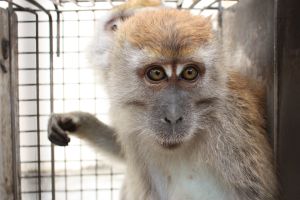
This recently published research took place at Columbia University in New York. It was supported by the US taxpayer and was approved by the Columbia University institutional animal care and use committee. Fourteen long-tailed macaques (Macaca fascicularis; from Charles River Primates, Wilmington, MA) were used; seven as 'donors', seven as recipients. In order to 'condition' the monkeys for liver transplant surgery, all 14 animals were subjected to massive irradiation in order to disrupt their immune system. This included the entire body and the thymus (a gland involved in the immune system). They were further immunocompromised by being poisoned with a compound that destroys T-cells (the compound was a Pfizer drug called ATGAM®) and metabolic toxin (cyclosporine; used to treat cancer by destroying certain immune cells). Some monkeys also received further drug treatment in order to alter their immune response. After the monkeys were 'conditioned', they were subjected to substantial intervention and complex surgery to remove the liver and bone marrow from 'donors' and implant into the recipients. This resulted in all the 'donor' monkeys being killed on the surgery table.
Very little was reported on the postoperative conditions for the monkeys; nothing at all about how the monkeys fared, their appearance or their behaviour. However, a description of some of the complications following the transplantations graphically illustrates the appalling nature of the suffering and misery these intelligent and sensitive animals must have experienced. For example, bleeding could not be stopped in one monkey, who then was subjected to a splenectomy. Another monkey never even made it off the surgery table due to an "anesthetic complication" which resulted in the monkey being killed. Another monkey developed serious problems with the lungs and was killed due to respiratory complications four days after surgery. Another was killed on day 10 after surgery due to bleeding. A fourth individual suffered an anesthetic complication during additional surgery and was killed. Out of the remaining monkeys who were still alive, one was killed on day 57 after the recurrence of an earlier complication and another had to be killed on day 69 following a rejection complication.
The monkeys continued to be immunosuppressed for 28 days after transplant surgery. When this was stopped, all the livers in the recipient animals were rejected. Thus, the protocol being tested to see if it would improve acceptance of the livers did not work as hypothesised. What did happen, however, is that 14 monkeys had their lives taken from them, but not until they had been subjected to 'treatment' that caused extreme suffering, including radiation that crippled the immune system, poisoning and many hours of complex surgery and days of recovering from such surgery. For the seven individuals who received the liver transplant, their lives were impacted further by post-transplant complications resulting in a major departure from their normal health. Seeking new and improved medical interventions and treatments for human suffering, illness and disease is important. Action for Primates, however, believes that it is morally unacceptable to do so by purposefully inflicting suffering, illness and disease on another species, especially one who has been shown to suffer similarly to people.
Reference:
22 July 2020: Haywood County applauded for maintaining its ordinance that prevents the keeping of non-human primates as pets

Action for Primates, a not-for-profit group that campaigns on behalf of non-human primates worldwide, has applauded Haywood County, North Carolina, for maintaining its strong stance prohibiting the keeping of all species of non-human primates in private homes ('pets').
A petition to the Board of Commissioners, discussed at a public hearing on 15 June, had proposed an amendment to Haywood county's dangerous animal ordinance (Chapter 91: Animal Services Ordinance) that, if accepted, would have granted an exemption to capuchin monkeys, thereby allowing people to keep them in private homes. After some discussion at its meeting on 20 July, the Board of Commissioners did not approve the exemption, thus the ordinance remains unchanged.
Every state in the USA has laws which deal with so-called exotic and wild animals in general, either allowing, restricting or prohibiting their being kept in private homes ('ownership'). In some states, such as North Carolina, the law allows individual counties and cities to create ordinances regarding these animals.
In Haywood County, the ordinance bans the keeping of certain wild animals, deemed to be inherently dangerous to persons or property
, in private homes. Currently, this includes all non-human primates. The petitioner for the proposed amendment argued that capuchin monkeys are not inherently dangerous, are easily 'domesticated' and do not have an aggressive nature.
Dr Nedim Buyukmihci, Emeritus Professor of Veterinary Medicine at the University of California and adviser to Action for Primates, wrote to the Board of Commissioners urging it not to support the proposed amendment, citing his own many years of experience with non-human primates.
Dr Buyukmihci stated: It is good news that Haywood County will be maintaining its prohibition of keeping any non-human primate in private homes. Non-human primates are wild animals and do not belong in captivity in people's homes or back yards. Contrary to the assertions of the petitioner, capuchins cannot become 'domesticated' by keeping them in human homes and they, like all non-human primates in captivity, can become extremely aggressive, causing serious injury to people. Non-human primates belong in their natural habitat, living freely. From an animal welfare and public safety perspective, the Commissioners have made the right decision.
Action for Primates believes that the keeping of any non-human primate as a 'pet' seriously compromises the health and welfare of the animal. It also creates a substantial danger and health risk to people. These are wild animals (even if born in captivity) and cannot be domesticated. As non-human primates mature and become physically stronger, they – even small monkeys like capuchins – become unpredictable and aggressive towards people and can cause serious injuries. To deal with this aggression, people often resort to cruel means such as removing teeth and nails in the erroneous belief that this will prevent injuries. These mutilated individuals, however, can and do still inflict injuries on people.
19 July 2020: Macaques used in outrageous and frivolous "monkey piano" experiment
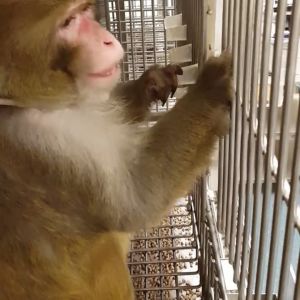
The work was carried out at Georgetown University Medical Center, Washington, DC, but also involved researchers from Finland (Aalto University School of Science) and published in June of this year (1). As with virtually all research on non-consenting beings, it was approved by an institutional committee, in this case the Georgetown University Animal Care and Use Committee.
This research was funded in part by the US taxpayer (National Institutes of Health and National Science Foundation). Some of the researchers were additionally funded by the Academy of Finland (a government funding body).
The researchers wanted to know why non-human primates do not have a more speech-like (or song-like) communication system, including vocal learning and volitional control
, despite their anatomical similarities to people.
Three rhesus macaques, named Do, Ra, and Ch by the researchers, were used in this experiment. They were initially 'trained', using food and fruit juice as 'rewards', to do certain tasks on what the researchers called a "monkey piano" – a keyboard device designed specifically for this research. In this video clip included in the publication, one monkey can be seen rotely pressing levers that produce sounds and then reaching for a bit of food presented on each correct sequence. The researchers did not state whether the macaques were initially subjected to fluid or food reduction or deprivation in order to 'motivate' them to carry out behavioural tasks, although this is commonly used in laboratories and is often the only way to get the animals to 'cooperate'. The research took place in the laboratory cages and sound booths.
Once they were 'trained', posts were surgically implanted into the monkeys' skulls and secured with ceramic bone screws, plastic strips and bone cement. These 'head posts' were used, in conjunction with a restraint device euphemistically called a 'primate chair' by researchers, to prevent the monkeys from moving their heads during the testing. From the visual media documented in the publication, it is clear that the monkeys also had to endure the continuous presence of a metal neck-collar.
After recovery from the surgery, the monkeys were restrained in a horizontal position in the 'primate chair', with their heads immobilised using the implanted posts. Shoulder electrodes were also applied to record muscle activity. Whole-brain functional magnetic resonance imaging (fMRI) was used to study the monkeys while they were presented with the sounds they had 'learned' (or ones they had not) through in-ear headphones to see if the researchers could identify how the information was being processed in the brain. The macaques had to endure hundreds of trials during multiple scanning sessions.
The researchers claim their study shows that macaques can learn to produce novel sound sequences with their hands by pressing levers ("piano keys") on a keyboard.
The public are repeatedly told that non-human primates are only used in research when absolutely necessary and only when there are no other alternatives available. We do not know if the researchers in this study would offer that defence, but it is patently clear that the work has no importance to non-human primates and certainly has no applicability to people. Furthermore, the same sorts of studies could easily be done in people – and have been done – to see what part of the brain is involved in various activities, including playing the piano (2), using the same kinds of sophisticated methods used by these researchers. Such studies provide the kind of information what would actually help people. It is shocking that, instead, these intelligent and sentient beings were cruelly exploited in this experiment. They were not only deprived of a normal life, they also had to endure surgical mutilation, extreme restraint and the monotony of hours of 'trials'.
References:
This is an open access article distributed under Creative Commons Attribution-NonCommercial-NoDerivatives License 4.0 (CC BY-NC-ND)
18 July 2020: The global trade in non-human primates captured from the wild
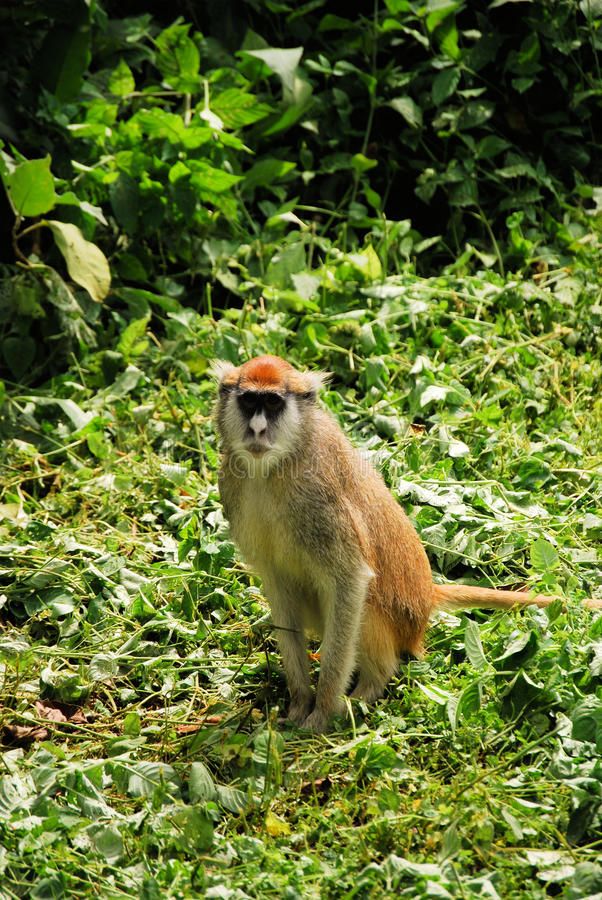
Over 4,000 wild-caught non-human primates were traded globally during 2018, the most recent year for which there are data. According to data submitted to CITES (Convention on International Trade in Endangered Species of Wild Fauna and Flora), eleven countries were responsible for the legal trade in exporting the wild-caught primates. The species traded included:
The other countries to export wild-caught non-human primates during 2018 were Ghana, Ethiopia, Benin and Mali. Guyana exported the greatest number of individuals, over 2,000, primarily to China.
The capture and removal of free-living non-human primates from their native habitats and social and family groups is, by its very nature, extremely cruel and inflicts great suffering and distress on the animals, as well as resulting in injuries and even death. Several official entities and organisations recognise the suffering involved in the capture. For example, the International Primatological Society states:
...the capture of nonhuman primates from the wild is stressful for the animals and increases the suffering, risk of injuries, spread of disease and even death during capture, storage and transport
Trade in Primates Captured in the Wild
Although, there has been a gradual reduction in the global trade in wild-caught primates over recent decades, the fact that such a cruel trade is still legal and allowed to continue is shocking.
The reasons given by countries for granting permits to import these wild-caught individuals during 2018 were mainly for the purposes of 'trade', 'breeding' or 'zoo'. However, wild-caught green monkeys (Chlorocebus aethiops) from St Kitts & Nevis were imported by the USA for 'medical', 'scientific' and 'trade' purposes.
China was by far the largest importer of wild-caught non-human primates in 2018, followed by Thailand. Other countries that reported such imports included the USA, Ubekistan, Benin, Kuwait, Dominican Republic, and Austria.
A further consideration is that these data did not include the offspring of non-human primates who were themselves trapped in the wild (coded 'F1'), or those from breeding farms that continue to capture wild non-human primates for breeding purposes (coded 'F'). For example, not included were the thousands of long-tailed macaques traded as captive-born (but who had wild-caught parents) from countries such as Mauritius to the USA and Europe for research purposes.
Any trade in non-human primates is unacceptable, and it is disheartening that despite a welcome reduction in demand for wild-caught non-human primates for research purposes, this was offset by a rapid increase in large-scale breeding farms for macaques in countries such as Cambodia, China, Laos and Vietnam, to supply the global research industry. It is also a trade that often continues to rely on wild populations to establish and replenish breeding groups, which raises serious questions regarding the legitimacy and status of captive-breeding claims. There is no way to know whether a particular individual was wild-caught or captive-bred.
15 July 2020: Non-human primate importation into UK has increased
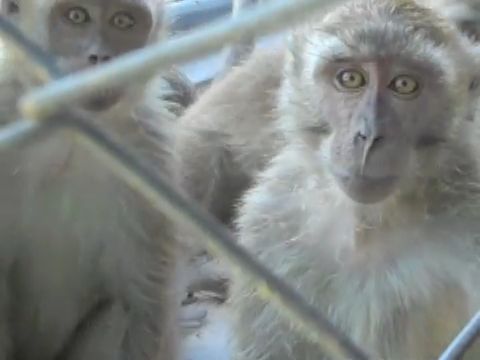
Action for Primates' findings on the increase in non-human primates imported into the UK for research purposes has been reported in The Independent, the UK daily online news publication. In 2019, permits were granted for 6,752 long-tailed macaques (Macaca fascicularis) to be imported, 6,120 individuals from Mauritius and 632 from Vietnam. Click here for the article.
The long-tailed macaque is the most heavily traded non-human primate globally and the most widely used in research and testing. Mauritius is the UK's main supplier of long-tailed macaques for research, and includes the offspring of wild-caught parents.
Data obtained by Action for Primates also show that during 2019, permits for the import of 38 other non-human primates were granted by the UK government, including twenty-seven individuals who were captured from the wild. The permits listed 25 squirrel monkeys (Saimiri sciureus) from Suriname, two red howler monkeys (Alouatta macconnelli) and four bearded sakis (Chiropotes chiropotes) from Guyana and seven black lion tamarins (Leontopithecus chrysopygus) from Brazil. All 38 individuals were apparently imported for breeding purposes. The UK still allows monkeys to be imported and kept as 'pets', so these individuals may have been destined for the 'pet' trade.
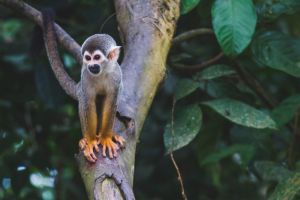
A UK ban on the importation of wild-caught primates for research took effect in 1997, although this ban does not include the importation of the offspring of wild-caught parents, nor does it include the importation for other purposes such as for breeding or the 'pet' trade. The capture of wild monkeys inflicts significant suffering and distress. These animals are highly social animals and trapping and removing them from their habitats, families and social groups is extremely cruel. It is highly disturbing that the UK is continuing to support a trade that involves such cruelty.
Campaign to End Wildlife Trade, a coalition of UK animal protection and conservation groups (including Action for Primates), is calling on the UK government to secure a global ban in wildlife trade at the G20 meeting in November 2020 and to end the importation and export of wild animals into the UK.
Please join us in demanding an end to the global trade in wildlife by signing and sharing this petition: Demand an end to the cruel wildlife trade.
Please help the monkeys in Mauritius
14 July 2020: Conservation status for Macaca fascicularis moved to 'Vulnerable' on IUCN Red List of Endangered Species
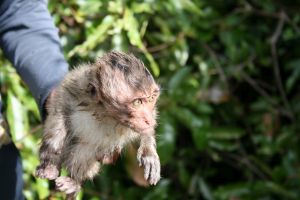
A new global assessment by the International Union for Conservation of Nature's (IUCN) Red List of Endangered Species has moved the conservation status of Macaca fascicularis (long-tailed or crab-eating macaque) from a species of 'Least concern' to 'Vulnerable' with a decreasing population trend. Action for Primates is calling on governments to take action to protect their populations of long-tailed macaques.
Further information on the IUCN assessment: https://www.iucnredlist.org/species/12551/17949449.
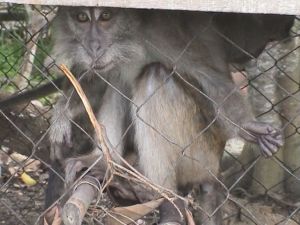
There are at least ten subspecies of the Macaca fascicularis, with a range covering Bangladesh, Brunei Darussalam Cambodia, India (Nicobar Is), Indonesia, Lao People's Democratic Republic, Malaysia, Myanmar, Philippines, Singapore, Thailand, Timor-Leste and Vietnam.
It is thought that the long-tailed macaque has suffered a drastic decline in numbers (over 30%) throughout its range in the last 36-39 years. The IUCN assessment states that "ignorance and lack of conservation action on an apparent 'abundantly' seen species will continue to impact its status in the future" and further reductions in populations are likely to occur. Further, although long-tailed macaques are widely distributed and adaptable to habitat changes, "the excessive hunting and persecution due to negative interactions with humans throughout its range is a cause for concern."
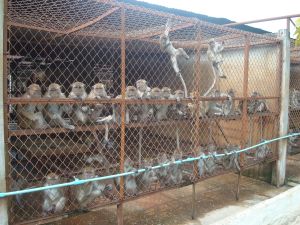
According to the new IUCN assessment, threats to the species, aside from hunting for food and 'sport', include capturing animals for breeding and laboratory research, which led to a rapid surge in international trade of this species. These macaques are exported around the world in the thousands to laboratories each year, and the breeding and supply of the species for research has developed into a large-scale enterprise especially within Southeast Asia, including Vietnam, Cambodia and Laos.
The long-tailed macaque is also relentlessly persecuted as a 'pest', often following human encroachment on their natural habitat which results in conflict with people. In some countries, the solution to dealing with this conflict is often to kill the monkeys rather than resolving it humanely. As an example, Action for Primates recently called on the Philippines not to allow the capture of wild long-tailed macaques for breeding and research purposes, after it was reported that the Department of Environment and Natural Resources was considering whether to grant such permits, citing an increase in the monkey population and conflicts with people. We are still waiting for a response.
Please sign and share our petition to the Philippines: Urge the Philippine Government to deny the capture of wild monkeys for research purposes, and write to the Philippine officials: Contact information.
6 July 2020: Monkeys suffer and die in pneumonic plague research to compare survival rates for delayed treatment with two well-known antibiotics
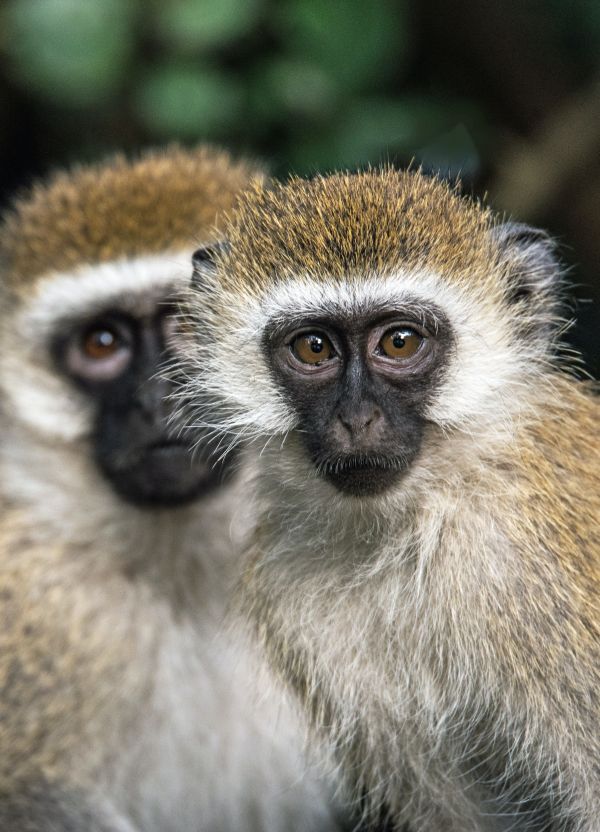
Pneumonic plague is a severe lung infection that, if left untreated, can very quickly become fatal. It is caused by the bacterium Yersinia pestis. Symptoms in people include fever and headache, developing into pneumonia with shortness of breath, chest pain and cough. Pneumonic plague can be fatal within 18 to 24 hours of disease onset if left untreated, but strong antibiotics, such as ciprofloxacin and levofloxacin, can effectively cure the disease if they are delivered early.
In this recently published experiment (1), 79 grivet monkeys (Chlorocebus aethiops) were used. They were all infected with a known lethal dose of the bacterium through inhalation in a head-only aerosol exposure chamber. The animals were divided into two groups, each group receiving either ciprofloxacin or levofloxacin as a treatment. Each group also contained eight monkeys who acted as a 'control' and received no treatment.
This research was funded by the taxpayer and took place at the National Institute of Allergy and Infectious Diseases, Rockville, Maryland, USA.
The objective of the study was to see the effects of delaying treatment with ciprofloxacin or levofloxacin after the onset of fever. This was an especially inhumane experiment because survival was the primary endpoint. The monkeys were observed for 21 or 28 days post-infection. Five animals died before treatment was begun. Fourteen of the treated animals and all 16 of the 'control' animals died. Of the latter, some were allowed to suffer for as long as 76 hours after the onset of fever. Any surviving animals at the end of the observation period were killed.
The authors do not mention the clinical signs shown by the monkeys after infection and before their death. The only reference is: Animals that did not survive until the time of scheduled euthanasia were either found deceased or found to be moribund and euthanized ahead of schedule.
There is no question, however, that these monkeys suffered substantially, without any attempt to alleviate this. The rapid deaths, the use of 'control' animals receiving only a placebo and the focus on survival as the endpoint all present a disturbing picture of the way in which these monkeys were treated, as if they were mobile Petri dishes rather than sentient, intelligent beings. We can safely assume that, like people, monkeys infected with pneumonic plague suffer from fever, headaches, shortness of breath, chest pain and cough.
Aside from the appalling suffering these monkeys endured, what is also shocking is that a) the two antibiotics - ciprofloxacin and levofloxacin - are already on the market and used to treat pneumonic plague in people, and b) it is already known that early intervention with antibiotics is essential and effective against pneumonic plague in people (2).
References:
Antibiotic treatment is effective against plague bacteria, so early diagnosis and early treatment can save lives.
4 July 2020: No patents on genetically engineered chimpanzees!

The European Patent Office (EPO) has ruled that two patents held by the US company Precigen (previously Intrexon) on genetically engineered chimpanzees and other animals are no longer valid. This is significant because it is the first time that such a ruling has been made for ethical reasons. It follows the successful opposition and appeals filed by a coalition of animal welfare and environmental groups, including Test Biotech, No Patents on Life, Jane Goodall Institut Deutschland and Cruelty Free International.
The patents had claimed genetically engineered chimpanzees and other animal species as 'inventions' for use in animal experiments. European law prohibits patents on the genetic engineering of animals if it is likely to cause suffering, although exceptions are allowed if there is evidence of medical benefit. According to the EPO, no such benefit had been shown with these two patents.
Following the ruling, Dr. Jane Goodall, DBE Founder of the Jane Goodall Institute & UN Messenger of Peace, stated: Chimpanzees are our closest relatives with whom we share 98.6% of the composition of our DNA, and this ruling will be appreciated by all who understand that modifying the genes of these apes and other sentient animals is unacceptable. The EPO has made a wise and responsible decision which sends a clear message to scientists who regard sentient beings as mere research tools.
Further information: https://www.testbiotech.org/en/press-release/no-patents-genetically-engineered-chimpanzees
30 June 2020: Monkeys infected with Marburg virus in cruel and inhumane research at US Army Medical Research Institute
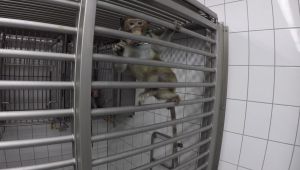
Action for Primates and Animal Rights Foundation of Florida have criticised an experiment, recently published in The Journal of Infectious Diseases, which was carried out to study the effectiveness of remdesivir in macaques deliberately infected with Marburg virus, some of whom were left untreated (1). Remdesivir is an antiviral drug developed by Gilead Sciences, and, according to a conflict of interest statement, five of the authors of the paper were current or former employees and may be shareholders in the company. The remaining authors were from the United States Army Medical Research Institute of Infectious Diseases (USAMRIID) and The Geneva Foundation. The research was funded by taxpayer money.
Marburg virus causes a highly virulent disease which results in haemorrhagic fever, with a fatality rate of up to 88% in people. The Marburg virus is classified as a Category A biowarfare agent by the Centers for Disease Control and Prevention (CDC) and there are no vaccines or effective therapies currently available (2).
In the experiment, 24 long-tailed macaques (Macaca fascicularis) supplied by Worldwide Primates, Florida, were deliberately injected with the Marburg virus and kept in a biosafety level 4 (BSL-4) laboratory at USAMRIID, Frederick, Maryland. Eighteen of the monkeys were given different doses of the test treatment (remdesivir) starting 4-5 days after the virus injection. The remaining six individuals, who were 'control' animals, received no treatment. Blood was taken from each animal via a leg vein on days 0, 3, 4, 5, 6, 7, 8, 10, 14, 21, 28, 35, and 41 post-inoculation. When blood was taken, the monkeys were given ketamine.
According to the published research, all the 'control' monkeys developed acute signs characteristic of Marburg virus disease infection, such as fever and rash, behavioural depression and deteriorating physical responsiveness. They were either allowed to die or were killed 7 or 9 days after infection because of the severity of their suffering. Many of the monkeys who had received treatment also became ill (although they had an "increased survival" rate) and died or had to be killed. All monkeys who were still alive at the end of the observation period were killed for further study. The postmortems carried out showed that some of the animals had incurred major organ damage as a result of the virus.
According to the CDC, the onset of symptoms for Marburg virus disease in people is sudden and includes fever, chills and muscle pain, followed by nausea, vomiting and diarrhoea. The illness becomes increasingly severe and can include substantial weight loss, massive hemorrhaging, shock, liver failure and multiple organ dysfunction (3). Given that the Marburg virus infection in the monkeys in this experiment was stated to have caused disease similar to that in people, we have to assume that at least some of these gruesome and highly painful conditions described by the CDC were present in the monkeys. The monkeys were not stated to have received any medication to ease their suffering.
Dr Nedim Buyukmihci, Emeritus Professor of Veterinary Medicine, UC Davis California and representative of Action for Primates, who has reviewed the publication, stated: There is no doubt that these macaques suffered horrendously during this experiment. Unfortunately, this is not an isolated situation and many thousands of other non-human primates are caused to suffer greatly as a result of the search for treatment and vaccines against viruses such as Marburg, Ebola and, most recently, the coronavirus responsible for Covid-19. Although the search for treatment or vaccines against such viruses is crucial to reducing suffering and death in people, we should not be causing equal or greater suffering in others such as non-human primates. Aside from the moral implications of using non-human primates in this way, there is also the sound scientific argument that animal research cannot be relied upon to produce safe and effective treatments for people. As moral and intelligent beings, we need to employ research methods that are humane and effective without intentionally causing suffering and death in others.
Nick Atwood, Animal Rights Foundation of Florida, said: We are saddened by the Florida connection to this experiment that resulted in the horrible suffering and death of many monkeys. The use of monkeys in the search for a Marburg virus or COVID-19 vaccine is not only cruel, but is unnecessary and often produces misleading results. We need to focus instead on human-based research methods.
Remdesivir was originally developed as a treatment in people for Ebola and Marburg infections, but did not demonstrate clinical efficacy (4). Research with remdesivir has since been revived with the outbreak of Covid-19 (5).
References:
22 June 2020: Male macaques in Korean laboratory subjected to surgical mutilation to make them 'safer' for people
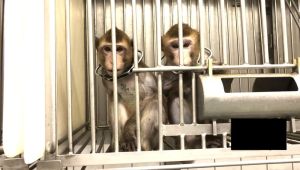
Researchers in Korea, who support the reduction of canine teeth in non-human primates, have subjected 10 male macaques (8 rhesus and 2 long-tailed) to major mutilations of canine teeth to study the impact of the surgery (1). This recently published work was carried out at the Biomedical Research Institute at the Seoul National University Hospital, South Korea and was approved by their Institutional Animal Care and Use Committee.

The removal or reduction of healthy teeth of non-human primates for non-medical reasons, such as in a laboratory or a private home in which a monkey is being kept as a 'pet', is a major welfare and well-being issue and is not supported by many, including the American Veterinary Medical Association (AVMA) who believes the practice is inappropriate for humane and safety reasons (2).

The oral surgery was carried out to cut off the outer part of the canine teeth and to expose the pulp. Some of the pulp was removed and the teeth were capped. The researchers had to use cotton soaked in a blood-clotting agent to stop the bleeding from the tooth during surgery. The monkeys were monitored from two months to two years and five months. One monkey developed a tooth abscess after the surgery.
The authors acknowledge the limitations of the research. Tooth abscesses usually occur two to three years after canine teeth reduction, but only two of their monkeys could be observed past two years. This means that the authors do not know whether their means of tooth reduction might, in addition to the immediate problems, result in serious oral disease later. Incredibly, the other limitation was that the authors had no access to a dental radiograph machine. An important part of all dental work is the use of radiographic images to study the progress of a condition.
This casual approach to inflicting additional pain and suffering on non-human primates for an 'experiment' that was simply done to see if mutilating the canine teeth would result in a 'safer' situation for people with respect to being bitten by the monkeys is shocking. The authors even acknowledged that the issue of tooth reduction is an animal welfare issue and that the procedure is "soundly opposed" by the AVMA and the Association of Primate Veterinarians, is rarely done or approved by institutional animal care and use committees in the US. Their justification that the procedure "...may have value to institutions outside of the United States of America" fails to recognise that it matters not where the monkeys reside: they suffer similarly.
References:
This article is licensed under a Creative Commons Attribution 4.0 International License.
21 June 2020: The cruel and inhumane trade in wild animals as 'pets'

Fourteen baby wedge-capped capuchins (Cebus olivaceus), smuggled from the South American mainland as part of the illegal 'pet' trade, have been rescued by police and the Forestry Division from a house in south Trinidad. One infant was found dead amongst the others, all crammed inside a wicker basket. Captured in their forest homes in South America and taken from their mothers, these monkeys suffered horribly for this cruel trade in animals' lives. Seventeen yellow-headed parrots and one macaw were also seized.
News media article: Trinidad: Venezuelan held after rescue of monkeys, parrots, macaw
19 June 2020: Campaign to end captive wildlife tourism
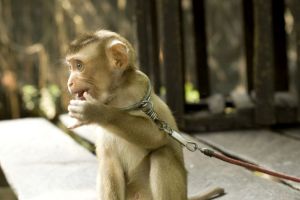
On 28th May 2020, Action for Primates joined over 230 NGOs and 26 travel companies in endorsing an Open Letter to the United Nations World Tourism Organisation (UNWTO). The letter, spearheaded by World Animal Protection, was in response to its recommendations to support governments, the private sector and the international community to mitigate the impact of the Covid-19 crisis by focusing on rebuilding a more sustainable and resilient tourism sector.
In this Open Letter, we urged the UNWTO to include the transition away from wildlife entertainment towards wildlife-friendly tourism as a key component of their global recommendations. We highlighted the fact that poor animal welfare conditions accelerate disease emergence and that the capture, handling and close contact with wildlife creates unnecessary opportunities for viral spread.
We also stated that the COVID-19 crisis has proven that this unnecessary close contact between humans and wildlife has catastrophic and devastating effects. And that we believe that the transition to wildlife friendly tourism is not only better for animals and for people, but is also integral to the secure and sustainable future of the global tourism industry.
Since the release of our letter, the UNWTO has published their Global Guidelines to Restart Tourism and their One Planet Vision for a Responsible Recovery of the Tourism Sector. Disappointingly, none of these documents refer to the importance of protecting captive wildlife from entertainment as part of a responsible recovery of the tourism sector.
If the UNTWO wants to balance the needs of people and our planet, as well as making sustainability the new norm, we believe that they need to also ensure that wild animals are kept in the wild, where they belong. We urge the UNWTO should make a clear statement that, as part of their vision, they are asking the sector to offer responsible and wildlife-friendly experiences and phase-out wildlife entertainment from their supply chain.
The transition to wildlife-friendly tourism is not only better for non-human animals and people, it is integral to the secure and sustainable future of the global tourism industry. This will:
18 June 2020: Plight of threatened species, including slow lorises, smuggled into Japan for exotic 'pet' trade
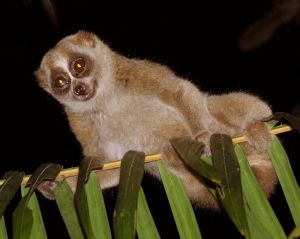
The plight of slow lorises and other endangered species in Japan's exotic 'pet' trade has been highlighted in the UK's Independent following a report released by TRAFFIC (1). The research carried out by TRAFFIC found that large numbers of threatened species are being smuggled into Japan for the exotic 'pet' trade (2).
The TRAFFIC study was based on analysis of seizures by Japan Customs, news media reports and conviction records, including cases resulting from police investigations after animals had passed through borders. Of the 185 non-human primates who were seized, 119 were slow lorises, including 94 pygmy slow lorises (Nycticebus pygmaeus).
There are four species of slow loris and all are listed as Appendix I on CITES (Convention on the International Trade in Endangered Species of Wild Fauna and Flora) which bans their international trade (3). Listed as a 'vulnerable' species on the IUCN Red List of Threatened Species with a decreasing population, threats facing the pygmy slow loris include hunting as a food source, for use in traditional 'medicine' and as 'pets', along with habitat loss (4).
In Japan, slow lorises have became fashionable as "pets' following their endorsement by celebrities, social media and a frenzy in viral videos. This popularity is helping to fuel the illegal trade in these animals and has had a major impact on the wild populations of this nocturnal primate. Many of the primates may have their teeth cut or pulled out to make them easier to handle before being sold.
References:
14 June 2020: Disturbing vision research continues on new-born monkeys in the USA
Infant monkeys have their vision impaired to study chronic eye misalignment or 'squint'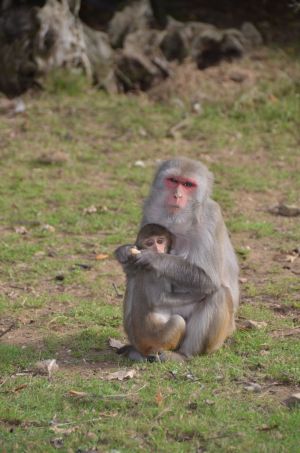
This recently published study was done at the Washington National Primate Research Center in Seattle, using public funds and was approved by the Institutional Animal Care and Use Committee at University of Washington (1). Three infant rhesus macaques were used. Two had muscles to their eyes cut during their first week of life to make them have strabismus (misalignment of the eyes, commonly known as 'squint'); the third was the normal 'control'. Once the monkeys were older (at around 3 years), they were subjected to surgery to implant head posts and recording chambers for brain electrodes, all into the skull. They also had scleral search coils surgically implanted into both eyes (under the conjunctiva) to measure eye movement. The head posts allowed the head to be restrained during experiments.
The experiment involved using visual stimuli and recording what went on in the brain. The monkeys were killed at the end of the experiments.
Although aimed at understanding amblyopia (a specific vision defect caused by 'squint') in children, the cruel method used on these baby monkeys resulted in a completely artificial situation. The experimental creation of 'squint' is fundamentally different from that naturally occurring in children. Further, and critically, there are substantial data already available from human studies and similar data can continue to be derived by such studies, data that will help children, rather than continuing to cause suffering in non-human primates.
One of the monkeys (referred to as XT1) in this study had been used in similar vision experiments by this research group going back several years. Other monkeys involved in past research in whom 'squint' was artificially induced at the same laboratory, included one who was forced to wear prism goggles for the first 3 months of her life to induce an imbalance in vision (2). Another infant monkey was injected with botulinum toxin into the eye muscle during her first week of life to cause muscle paralysis to simulate a form of 'squint' known as esotropia, the inward turning of one or both eyes (3). She received three follow-up injections with botulinum toxin between the ages of 4 months and 2 years.
In addition to being in captivity, these monkeys, as new-born infants, had to suffer damage or disruption to their vision either through cutting or paralysing the eye muscles or being forced to wear prism goggles. They also had to endure multiple surgeries and being restrained severely during the experiments; some individuals were used in several experiments over a number of years. All were then killed. We do not know if the new-born infants were also deprived of their mothers as this is not stated in the published work. Infant non-human primates have been used for decades in a misguided attempt at understanding human vision. Such research is not only morally reprehensible, it creates artificial situations that have little resemblance to what naturally occurs in human children. Where is the 'care' and oversight from the institutional animal care committee?
References:
7 June 2020: Monkeys still used in cocaine addiction research - how can this be justified?
Stimulant abuse is a major public health issue. Despite all the human misery involved in cocaine addiction, researchers continue to deliberately inflict even more misery by causing non-human primates to take this drug. Shockingly, non-human primates have been used in drug addiction research for more than 70 years, and it still continues. Despite the enormous cruelty and suffering endured by these animals, there is still no FDA-approved pharmacotherapy for cocaine abuse in people.
This experiment was carried out in the USA on rhesus macaques (Macaca mulatta), who were used as a representation for human addiction, to see if a test drug (which produces similar effects to cocaine) reduced cocaine self-administration. Aside from the immorality of using non-human primates in such despicable research, the complex combination of factors involved in human addiction - including genetics, emotional and personal experiences, socioeconomic factors - can never be simulated in others.
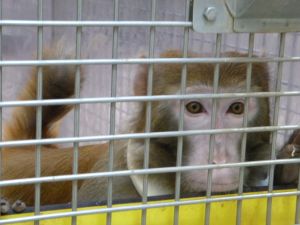
The study, carried out at Wake Forest School of Medicine in North Carolina, was funded by the taxpayer and approved by its Animal Care and Use Committee (1). Six rhesus monkeys housed on their own were used. The monkeys were anaesthetised and a catheter was surgically implanted into a major vein (femoral, internal or external jugular) and threaded under the skin to a subcutaneous vascular port implanted over the back, in order for the cocaine to be injected directly into the animals' bloodstream. Each monkey, fitted with an aluminium collar, was, according to the authors, "trained" to sit, restrained by their necks in a standard primate restraint apparatus. No information was given as to how the monkeys were "trained" to achieve this. During the testing, the restrained monkeys were held individually in sound-attenuating isolation chambers, containing switches that allowed them to self-administer cocaine or the test drug. The sessions could last for as many as four hours.
There is no information provided on the welfare of the six monkeys during the experiment nor on what care they received after being injected with cocaine or the test drug. The use of sanitised phrases by the authors, such as "...six cocaine-experienced male rhesus monkeys" and "...subjects had extensive experience self-administering cocaine.." to describe the history of the rhesus macaques in the current experiment, provides a disturbing insight into the lives of these sentient beings. We have to wonder for how many years these intelligent and social animals have been held in captivity and how many times have they been used in drug addiction experiments?
Cocaine is a dangerous drug and poses a serious health risk to people, including organ failure and death. Common signs of cocaine use include long periods of wakefulness, loss of appetite, paranoia, confusion, over-excitement, seizures and depression. It is reasonable to assume that the monkeys being forced to 'use' this drug experience the same. It is not reasonable, however, that they should suffer in a quest to provide a 'magic pill' treatment for people. Further, this is one more example of how institutional animal use and care committees, highly tauted by the research community, fail to protect the animals.
Reference:
1 June 2020: Monkey maternal deprivation experiments continue in the USA
Newborn monkeys are still being taken from their mothers in publicly funded research
A recent publication has described a study involving the separation of newborn rhesus macaques from their mothers at birth (1). The work was carried out at the Laboratory of Comparative Ethology and National Institute of Child Health and Human Development in Poolesville, Maryland, USA. The research, funded by the National Institutes of Health (thus taxpayer money), was carried out to assess individual differences in maturation and temperament in early development (the first four weeks of life) in rhesus monkeys reared in what are described as "normative and impoverished early conditions". Six hundred and sixty-eight infant rhesus macaques were randomly assigned to one of two rearing conditions: 307 were raised with their mothers and 361 were separated from their mothers at birth and hand-raised in what the authors refer to as a "neonatal nursery".
The study was not done to help monkeys nor are the data of any value to rhesus monkeys. Instead, it was done to learn more about rhesus macaques in a laboratory setting in order to use them as "models" for human infants in other experiments looking at temperament. There is no mention of what happened at the end of the experiment to the 361 infants separated from their mothers, although it is implied that the monkeys used would continue to be in the 'colony' and used for other experiments over time.
Primate maternal deprivation and social isolation experiments have been going on for decades, including the cruel and deeply unethical experiments carried out by Harry Harlow in the USA in the 1950's, that caused such suffering and mental anguish to infant monkeys. At least one author of the current work is a 'disciple' of Harlow and has been carrying out maternal deprivation studies for decades.
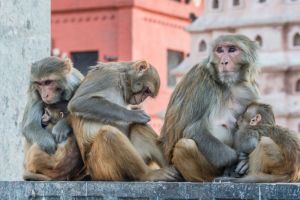
Unlike the offspring of many other mammals, infant non-human primates have a long period of dependence and development which requires an extended period of maternal care. In the wild, infants normally remain with their family group for many years. Natural weaning is a gradual process. Forcibly separating infants from their mothers is an extremely distressing experience for both the mother and infant and there are many studies from similar laboratories demonstrating the often severely negative effects which can last the life of the individual.
It is unacceptable that in 21st century America, it is still considered acceptable for newborn monkeys to be separated from and deprived of their mothers.
Reference:
29 May 2020: Envigo awarded $1.91 million US government contract to supply monkeys for coronavirus research
The US National Institutes of Health (NIH) and Office of Assistant Secretary for Preparedness and Response - HHS, have recently awarded $1.91 million in contracts to Envigo for the purchase of non-human primates, including long-tailed and rhesus macaques. Coronavirus research is the reason given for the purchase of these animals.
In 2015, Huntingdon Life Sciences (HLS) and Harlan Laboratories merged to become Envigo, a privately held contract research corporation that supplies animals and provides contract testing services for pharmaceutical and chemical companies as well as universities, governments and other organisations.
While the search for a vaccine against coronavirus is crucial, we must never forget that thousands of monkeys are suffering and dying in laboratories across the world in the rush to find one. Aside from the moral objections to using animals in research, Action for Primates fully supports a humane approach to the research needed - instead of using other sentient beings capable of suffering - to fight this virus in order to produce human-relevant, safe and effective treatments for people.
For further information, please read 'Coronavirus vaccine: a need for quick but humane and human-relevant action' by Dr Jarrod Bailey, Senior Research Scientist at Cruelty Free International.
More information: https://lancasteronline.com/news/local/federal-government-rents-monkeys-from-denver-business-to-fight-covid-19/article_d95a3d90-a11b-11ea-8aa5-c3701603f4cf.html
25 May 2020: The shocking deliberate killing of 42 baboon foetuses
This was publicly funded research to look at the effects of a nutrient restricted diet on the foetuses of pregnant baboons (1). After being fed such a deficient or control diet, 42 baboons had their uterus cut open under anaesthesia. The 42 unborn foetuses, some near full term, were killed while still attached to their mother.
Female baboons (Papio sp.) from a baboon colony maintained by the Southwest National Primate Research Center at the Southwest Foundation for Biomedical Research in Texas, USA, were used in this research. The researchers were attempting to simulate intrauterine growth restriction (IUGR) in humans, a condition involving the poor growth of a foetus while in the mother's womb during pregnancy. The research was funded by the National Institute of Health (NIH). Female baboons are regularly used in research for human female reproduction studies.
For the purposes of the research, the female baboons (between 8-15 years old) were allowed to become pregnant by being placed in groups with a male baboon. Once pregnant, about half the females were fed a control diet and the rest were fed an experimental maternal nutrient restricted (MNR) diet (70% of normal caloric intake), starting on gestational day 30. At gestation days 120, 140, 165 and 175, the baboons were anaesthetised and each had her uterus cut open. The foetuses were killed by being bled to death through the umbilical cord and then removed from their mother's womb. The normal gestation period for baboons is about 175-180 days (6 months), which means that some of the foetuses were almost at full term when they were killed. The mothers' surgical wounds were repaired. After recovery from anaesthesia, the mothers were returned to individual cages and eventually returned to their group cages. The tissues from each foetal group were compared.
We believe this was an appalling waste of life. The authors had already done studies in human volunteers (pregnant women with normal or growth-restricted foetuses) (2), the results of which are clearly more applicable to human beings and which did not involve the suffering of intelligent and sentient beings who could not give their consent, and the subsequent deliberate killing of their unborn babies.
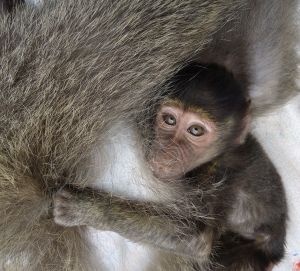
References:
23 May 2020: International Coalition calls on the Philippines to not allow capture of wild monkeys for research purposes
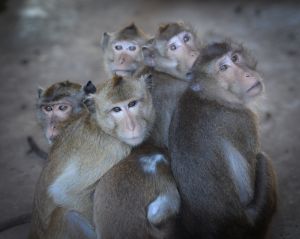
Action for Primates is delighted to have the support of the Asia for Animals Coalition, which represents a global network of hundreds of animal welfare and conservation organisations (including Action for Primates), in calling on the Philippines government to not allow the capture of wild long-tailed macaques for research. Amid growing concern about the fate of wild monkeys in the Philippines, the Asia for Animals Coalition has submitted an open letter to the Department of Environment and Natural Resources (DENR) urging it to refuse permit applications for the capture of these monkeys. If such permits are granted, it could mean a revival in farms breeding and exporting macaques for research, using newly trapped monkeys as a source.
The primate species in question is the long-tailed macaques (Macaca fascicularis spp. philippensis). In addition to the cruelty and suffering involved in the trapping of wild primates, this sub species of the long-tailed macaque is, according to the most recent assessment by the International Union for Conservation of Nature's (IUCN) Red List of Threatened Species, listed as 'Near Threatened' with a population that is decreasing (1). Threats identified for its decline were given as hunting and habitat loss. Also, because the species is listed under Appendix II on CITES, the Philippines, as a signatory to CITES, has a responsibility to safeguard its conservation status (2).
One of the reasons given by the DENR for considering whether to allow trapping is conflict arising between people and the monkeys. Instead, the Coalition letter points out the humane methods that can be used to resolve conflicts without resorting to the cruel capture, killing or export of monkeys. These measures, which include deterrents, sterilisation and education, result in a more effective and lasting reduction in conflicts. The letter also highlights the growing awareness of the fragility of the natural world and the negative and destructive impact that human activities are having on wildlife and the environment. It is, therefore, more important than ever that we look for humane ways in which we can coexist with other species.
To support this campaign, please sign and share our joint petition with the Philippine Animal Welfare Society (PAWS): https://www.thepetitionsite.com/en-gb/661/180/303/urge-the-philippine-government-to-deny-the-capture-of-wild-monkeys-for-research-purposes/
Please also write to the Philippine government. See our Take Action page for details.
References:
17 May 2020: Monkeys still being used to study effects of alcohol during pregnancy
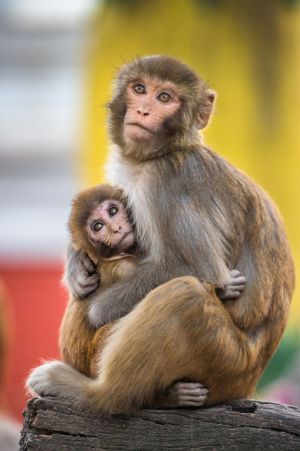
A recent publication shows that, in the USA, rhesus macaques (Macaca mulatta) are still being used in publicly funded research to look at the impact of drinking alcohol in early pregnancy in an attempt to simulate human fetal alcohol spectrum disorder (FASD) (1). The monkeys were "induced" to binge drink (roughly 6-7 alcoholic drinks, an amount known to cause intoxication in people) every day from before becoming pregnant and through the first trimester of pregnancy.
The experiments took place at the Oregon National Primate Research Center (ONPRC), a publicly funded entity and further supported by multiple grants from the National Institutes of Health (NIH). Twenty-eight rhesus macaques, presumably bred at ONPRC (source was not stated in the papers), were used. Half of them were "induced" (authors' term) to drink ethanol (alcohol) by using a food-reward system and eventually having alcohol-containing water as their only fluid source. When the monkeys consistently drank enough of the alcoholic fluid to achieve 1.5 grams of alcohol/kg body weight every day, this degree of daily alcohol consumption was continued for at least 30 days prior to conception and through 60 days of pregnancy (which is the 1st trimester in this species). The other half of the monkeys were "controls" and drank equivalent amounts of a non-alcoholic fluid each day.
The monkeys were individually housed in 76 x 60 x 60 cm stainless steel cages. Given that the average size (head and body length) of a female rhesus macaque is about 50 cm, this provided very little room even for normal postural adjustments and none for any meaningful exercise. Although other monkeys were in the same room and could be seen or heard, no socialisation such as touching or grooming, critical to monkey well-being, was allowed.
During gestation, the fetuses were examined by using magnetic resonance imaging (MRI) on the mothers. Normal birthing was not allowed. Instead, the fetuses were surgically removed at 85, 110 and 135 days gestation, killed and their brains examined to see if the alcohol consumption by the mothers caused any abnormalities and to see if MRI might have predicted such damage.
In addition to the major welfare issues for the monkeys, the work is seriously flawed because it is looking at a highly singular situation of just the effects of alcohol in a rigidly controlled environment. This in no way comes close to mimicking the situation for women in whom many other factors would modulate the effects of alcohol use, whether positively or negatively. These include environmental pollution, diet, the use of tobacco products (smoking), the taking of various medicines, the use of other drugs (such as marijuana, cocaine, etc), a person's psychological state (for example, if their life is extremely stressful for other reasons). Furthermore, the authors acknowledge that their 'sample size' was too small to reach any definitive conclusions even in their tightly controlled 'model', citing the cost of using monkeys as the major issue.
The authors point out that, due to its non-invasive nature, MRI could be used to study human fetuses that have been exposed to alcohol in utero to address the challenge of early detection of abnormalities. Such studies could provide information relevant to people rather than wasting resources on and causing suffering in monkeys. Instead, the authors state that future research using monkeys is anticipated, including allowing alcohol-treated mothers to give birth, so that their offspring can be studied.
An article in Mail Online (2) reports on other shocking experiments carried out at ONPRC and revealed by PeTA. According to the article, the taxpayer-funded experiments involved giving pregnant macaques high fat diets, alcohol and nicotine to study the effects on their offspring.
References:
15 May 2020: World Health Organization fails to support ban on wildlife markets
The World Health Organization (WHO), incomprehensibly, is not supporting a global ban on markets that sell live animals despite recognising that such markets can be the source of deadly epidemics for people, such as the current coronavirus pandemic. Instead, Dr Peter Ben Embarek, a WHO food safety and animal diseases scientist, said that authorities should focus on improving markets rather than banning them (1).
In April, a joint letter signed by over 200 animal welfare and conservation organisations called on the WHO to recommend to governments worldwide that they bring in permanent bans on live wildlife markets and close down or limit trade in wildlife to reduce the threat to human health (2).
At the same time, the United Nations' biodiversity chief called for a global ban on wildlife markets that sell live and dead animals for human consumption (3). A group of US lawmakers also called for such a ban, as well as a ban on the international trade of live wildlife to help to prevent the next pandemic (4).
The coronavirus outbreak has firmly placed wildlife markets under the spotlight. At these locations, many different species of animals, including non-human primates, are confined in cruel, crowded and unhygienic conditions to be sold for human consumption. Such brutal treatment of our wildlife, including their capture and the destruction of their habitat, is not only extremely cruel, but poses a major danger to human health with the risk of disease transmission. We are greatly disappointed that World Health Organization is not supporting the growing international calls for a global ban on these markets.
References:
10 May 2020: The disturbing truth behind monkeys used in street entertainment in Indonesia
This week, a story made headline news about a monkey in Indonesia on a bike who grabbed a child, demonstrating once again why keeping non-human primates in captivity is not just morally wrong, but also potentially dangerous. The child was obviously traumatised by the incident, as was the monkey. Abused for entertainment purposes in a practice known as topeng monyet, or 'masked monkey', monkeys are dressed up, often with dolls' heads clamped on their heads and forced to 'perform' in the street as 'entertainment'.
Exploiting and abusing wild animals, such as non-human primates, to 'perform' for human entertainment is cruel and inflicts immense suffering. The monkeys are usually kept on their own, permanently chained, in poor conditions and brought out for 'performances'.
The techniques used to force the monkeys to 'perform' are usually cruel and involve punishment and intimidation. Bipedal walking (walking on hind legs) is not natural for monkeys and can lead to long-term damage to joints and muscles. In order to get the monkeys to adopt this abnormal posture, the monkeys may be hung upside down and chains clamped around their necks. They are forced to stand up straight or be punished.
A national ban on topeng monyet in Indonesia was approved last year, following the work of Jakarta Animal Aid Network (JAAN). Lack of enforcement and not confiscating the monkeys has hampered bringing an end to this cruelty. JAAN has rescued and rehabilitated over 200 of these highly traumatised and abused monkeys.
News media article: https://www.vice.com/en_us/article/4aygmb/the-truth-behind-those-videos-of-monkeys-riding-tiny-motorcycles
28 April 2020: Japanese macaques forced to 'entertain' people in Japan
Japanese macaques (Macaca fuscata; also known as snow monkeys) are forced into 'entertainment' known as 'Sarumawashi' (monkey dancing or performance). These wild animals, indigenous to Japan, are made to wear face masks and costumes and carry out acrobatics and tricks to amuse people. Methods used to coerce the animals to carry out these tricks are usually aversive and cruel, and may involve intimidation and physical threats as well as forcing the animals into unnatural postures like standing on hind legs for long periods.
Thousands of wild Japanese macaques are captured every year because of human-macaque conflicts and attempts at population control. Most are killed, but some, especially infants, end up in 'Sarumawashi'. Incongruously, the wild macaques are encouraged to breed through artificial feeding at 'monkey parks' for the benefit of tourists. It is biologically and morally unacceptable to engage in practises that increase the number of monkeys only to kill them because they become a nuisance.
An article published recently in National Geographic contains compelling images of Japanese macaques carrying out demeaning acts and provides a disturbing insight into what is involved when the monkeys are forced to provide 'entertainment' for humans:
https://www.nationalgeographic.com/magazine/2020/03/japan-snow-monkeys-circus-like-performances-contradict-long-revered-status-feature/
17 April 2020: Crisis surrounding coronavirus outbreak highlights why it is wrong to feed wildlife
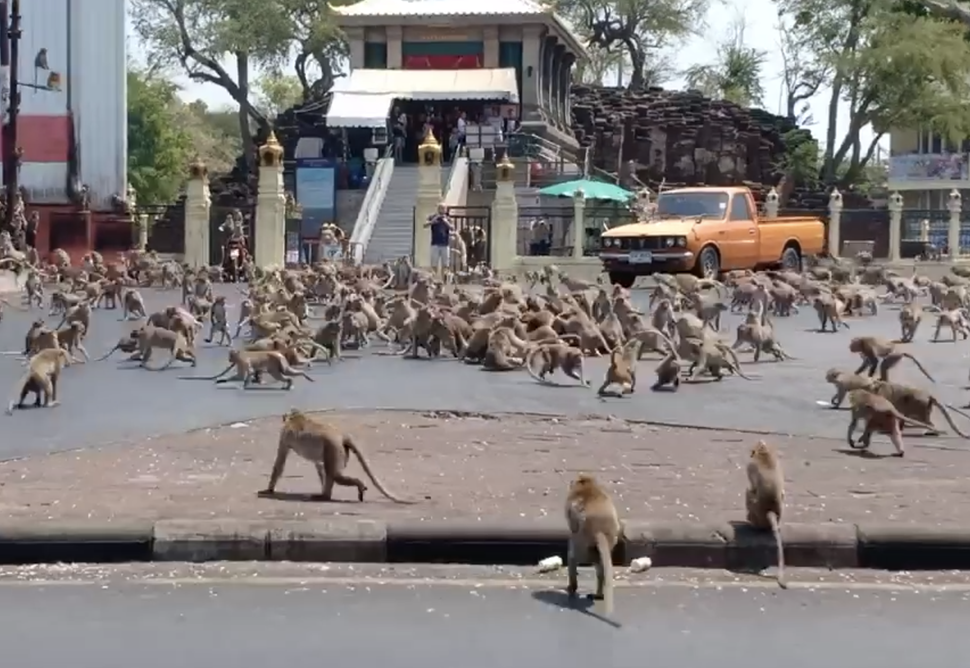
It is almost always the case that inappropriate behaviour by people is the cause of 'conflicts' with non-human primates. Encroachment upon and destruction of the animals' habitat is a major issue. Also important is the feeding of primates, whether by design or as a result of unsecured waste disposal. This 'supplemental' feeding results in several problems, including diminishing the animals' innate fear of people, providing a readily available source of food that is easier to procure than natural sources and increasing reproduction because of an artificial increase in carrying capacity.
The 'conflict' issue has come to the forefront as a result of the coronavirus outbreak. One of the tragic consequences of people feeding monkeys, especially tourists at well-known tourist spots, is the dependency on humans for food, and when that food is suddenly taken away, as it has been in Thailand with the current COVID-19 crisis, the monkeys suffer. Upsetting images of troops of wild monkeys searching and fighting for food are a graphic and timely reminder of how invasive the human species is in disrupting the lives of other animals. Government agencies must educate the public about the dangers of feeding wildlife in general and non-human primates in particular, and pass and strictly enforce legislation against this practise. People may think they are helping the animals, but, in reality, they are sentencing them to death every time they feed them.
News articles:
https://www.livescience.com/macaque-fight-thailand-temple-coronavirus.html
https://www.theguardian.com/world/video/2020/mar/13/hungry-monkeys-brawl-over-food-as-coronavirus-hits-tourism-in-thailand-video
https://www.theguardian.com/world/2020/mar/13/fighting-monkeys-highlight-effect-of-coronavirus-on-thailand-tourism
8 April 2020: Primates and Covid-19 research
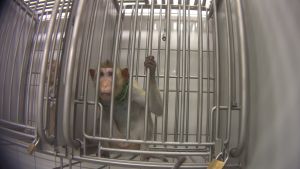
Non-human primates are also being negatively impacted as a result of the coronavirus. While the search for a vaccine against this virus is crucial to reduce suffering and death in people, we must not forget that thousands of monkeys, mainly macaques, will suffer and die deliberately in laboratories across the world. Aside from the moral implications of using animals in this way, there is also the scientific argument that animal research cannot be relied upon to produce safe and effective treatments for people (1, 2). The process whereby strict regulations are required for the testing and licensing of drugs that would normally take many years are instead being accelerated in the effort to find a vaccine against coronavirus within months. Contrary to standard practise, human clinical trials are reportedly due to start before animal tests have been completed (3). Nevertheless, non-human primates are being used in many laboratories as evidenced by an increasing number of news media reports highlighting several facilities:
References:
7 April 2020: Animal protection organisations call for ban on wild animal markets
Today on World Health Day, animal protection organisations are calling for a global ban on wild animal markets. A letter organised by Born Free Foundation and Lion Coalition, and supported by over 200 organisations, has been submitted to the World Health Organisation. Action for Primates supports such a ban. In these markets, highly stressed wild animals of many species, including primates, are kept in overcrowded and unhygienic conditions, before being slaughtered. Such brutal treatment of our wildlife, including their capture and the destruction of their habitat, is not only extremely cruel, but poses a major danger to human health with the risk of disease transmission.
Media coverage of this call for a global ban includes the UK Daily Mail.
6 April 2020: Global ban on wildlife markets recommended
The United Nations' biodiversity chief has called for a global ban on wildlife markets that sell live and dead animals for human consumption, such as the market in Wuhan, China, which is believed to be at the centre of the current coronavirus outbreak, although there is evidence that a person already infected may have brought the virus to the market.
The coronavirus crisis has shone a light on the exploitation and abuse inflicted by humans on other animals, including non-human primates, once again raising important questions about our relationship with wildlife and the planet. An end to our encroachment into and destruction of native habitats, the hunting and eating of wild animals and the brutal ways in which we dominate and terrorise other species with whom we share our world, is long overdue.
6 April 2020: Controversial primate dealer gets US contract to supply monkeys
The notorious Worldwide Primates, a company in South Florida that imports monkeys for research, has received a $1.8 million purchase order for monkeys from the US Department of Health and Human Services. The contract lists Coronavirus COVID-19 as the issue for 'national interest action'.
Matthew Block, founder of Worldwide Primates, has a felony conviction for a heinous animal smuggling case. In 1993, following the work of Dr Shirley McGreal and the International Primate Protection League (IPPL), Block pleaded guilty to felony conspiracy to violate the Lacey Act and the Endangered Species Act, for a smuggling deal, known as 'The Bangkok Six', that left three orangutans dead. He was sentenced to 13 months in federal prison and fined $30,000. In 2018, it was reported in the Miami Herald that Block pleaded guilty to a federal charge of intentionally conveying false information through the mail, in an attempt to frame animal campaigners in Florida. Block accepted five years of probation and agreed to pay $14,872 for the cost of the police investigation.
![]()
![]()
![]()
![]()
![]()
Contact us via E-mail
Copyright © 2020-2026 Action for Primates. All rights reserved.